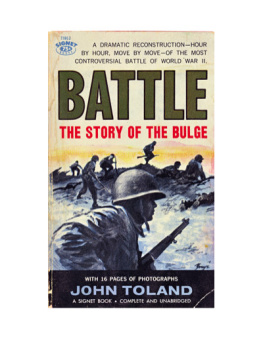PART ONE
Operation "Christrose"
1. THE GHOST FRONT
15 December 1944
The night of December 15, 1944, was cold and quiet along the Ardennes Front.
At 10:00 p.m. the American troops in Echternach, a quaint medieval town in the Grand Duchy of Luxembourg, were abed or going to bed in yellow patrician houses with dormer windows and mansard roofs. They saw no sign of activity from the Germans in the crumbling cliff-top abbey that overlooked them from across the swift narrow Sauer River. They had nothing to stay up for in Echternach itself. Since September, when the Americans had liberated Luxembourg at the end of their wild dash through France, the town's 3,300 citizens had been living in evacuation quarters behind the hills to the west.
Echternach, the southern anchor of the Ardennes Front, was being held by a single company of riflemen. And by 10:30 p.m. all but a few of them were asleep.
Twisting eighty-five miles through terrain reminiscent of the Berkshires and the Green Mountains, the front was held by six American divisions. Of these six, three divisions were brand-new and had been sent here to get "blooded" lightly tested in combat before being assigned to a major engagement; the other three, exhausted and bled white in battle, were here to be refitted, retrained.
For the Ardennes Front was the "Ghost Front"a cold quiet place where artillery was fired mainly for registration and patrols probed the enemy lines only to keep in practice. Within rifle range of each other, German observers watched the Americans eat, and the American observers watched the women come at dusk and steal into the pillboxes of the Siegfried Line. For over two months now both sides had rested and watched and avoided irritating each other.
From Echternach, the front swung northward along the winding Sauer River. The hill-straddling American lines were manned by the 4th Division, which the month before had suffered 7,500 casualties in the brief but bitter battle of Hrtgen Forest. On the German side of the river the battlement-like cliff continued, concealing the forward positions of the Siegfried Line.
About five miles north of Echternach the 9th Armored Division took over. Newly arrived in Europe, it had been in position for just a week. Actually only one combat command -roughly equivalent to an infantry regimentwas on the line; the other two were garrisoned in reserve fifty miles to the north. One week up front, and already the officers were worried: how could their men be battle-tested when there was so little action?
At 10:30 p.m. it was drizzling on the 9th Armored front "I'm living in a dugout," wrote Lieutenant Clifford Penrose to his wife, "and the damn thing is starting to leak tonight. So don't let a few blurred spots bother you, it isn't beer. We had Spam for supper tonight. And then your package came. Thanks a lot, but next time don't send Spam."
After six miles, where the Our River flows into the Sauer from the north, the lines were taken over by the 28th, another veteran infantry division that had suffered heavily in the Hrtgen Forest.
The front continued north along the Our. This fast-flowing river was only fifty feet wide, but the towering bluffs on both sides restricted vehicular crossing to a few places. One of these crossings, eight miles above the Our's confluence with the Sauer, was at Vianden, a picture-book town that crouches beneath the splendid ruins of a huge rambling castle. This fortress, which had held off Vianden's enemies for centuries, was now an observation post for thirty-six American soldiers.
At 11:00 p.m. most of the men in Vianden were asleep. But in the dining room of the Heintz Hotel, on a table that had served royalty, prime ministers, and great authors, several GIs were patching a boat and talking of the one-armed German sergeant who had been picked up earlier that night on the other side of the river. Ever since, the captive had kept crying in terror, "The Germans come tonight! The Germans come tonight!" He begged them to flee to the west and take him.
About fifteen miles farther north, the front crossed the Our and poked through the Siegfried Line into Germany. From this breach, the 28th Division positions continued almost due east for another seven or eight miles. Then the 106th Divisionthe Golden Lionsmanned the defenses.
This was not only the newest American division in the Ardennes; it was also the newest Allied division on any front. Transported across France and Belgium through cold rain in open trucks, the men had arrived, drenched and miserable, only a few days before. Immediately some encouragement had come their way. As they took over from the 2nd Division, those battle-wise veterans had shouted, "Lucky guys! You're coming into a rest camp!" And a regimental commander of the 2nd had told a regimental commander of the 106th, "It's been very quiet up here, and your men will learn the easy way." By now the young newcomersthese were the first of the eighteen-year-old drafteeswere cockier than the veterans and certain they "had it made" for the duration.
"Never expected your little boy to get this far, did you?" nineteen-year-old Pfc. Joe Schectman was writing to his folks in Plymouth, Pennsylvania. "We are billeted as comfortably and safely as we were in England. Of course there's no telling how long I'll be in this paradise. But as long as I am, I'll be safe."
And a few miles to his north 1st Lieutenant Alan Jones, Jr., a regimental staff officer, was staring dreamily from his bunker. He saw nothing but a typical Christmas card scene: icicles two feet long, snow-covered fir trees. At ease in this peaceful world he turned his thoughts to his wife Lynn in Washington, D.C. Soon she would have a baby, their first.
Young Jones's sense of tranquillity was not shared by his father, Major General Alan Jones, commander of the 106th Division. That day he had come up to the front lines and chatted with his son.
Noticing his father's .32 pistol, young Jones had remarked jokingly, "I could use that, Dad."
"I really should give it to you. But I might need it myself." General Jones's tone had been as bantering as his son's, but inwardly he was extremely worried. He had been worried from the first moment he had seen a situation map: his entire division was out on a salient thrust six miles into the Siegfried Line. This area, called the Schnee Eifel (Snow Mountains), was a range of rugged wooded hills, rolling fields, and twisting streams, with tiny villages squatting atop bald ridges or hidden in deep valleys. Through the Schnee Eifel ran miles of Hitler's "dragon's teeth"concrete tank trapsand hundreds of cleverly camouflaged pillboxes.
As soon as he had taken his positions"man for man and gun for gun," his orders saidJones had protested that this whole salient could easily be cut off. Too many of his defense points were located in villages in the valleys, and his men were open to attack from all sides and above.
But Generals Hodges, Bradley, and Eisenhower insisted that this finger sticking into the Siegfried Line would be a valuable bridgehead when Germany was invaded. That it could be bitten off was a risk, true, but only a small one.
Jones was also worried about a long narrow valley which lay just to the north of the Schnee Eifel. This valley was a seven-mile-wide corridor that led from Germany to Belgium. It was called the Losheim Gap.
Even the name conjured up danger. For the Losheim Gap was the classic gateway from east to west. Through it invading German armies had poured in 1870, in 1914, and in 1940. Although no one in his right mind believed the Germans would try a fourth time, Jones fretted. If they did, his men on the Schnee Eifel would be trapped.
All except the northernmost two miles of the seven-mile Losheim Gap was his to guard. Moreover, the five miles that were his responsibility were held by troops he had never seen, the 14th Cavalry Group. Jones had inherited these men from the previous occupants of the Schnee Eifel, the 2nd 'Division. As yet there had been no time for his officers even to visit their Losheim Gap positions.
Next page







